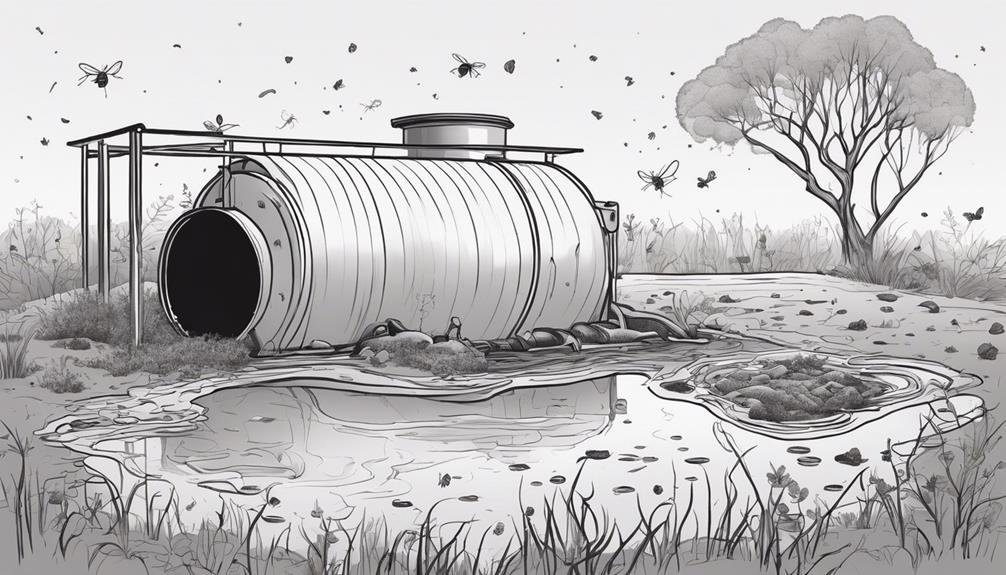
Causes of Septic Tank Odors and How to Eliminate Them
A septic system is a self-contained wastewater treatment system that is commonly used in areas where public sewer systems are unavailable. While septic systems are generally reliable, they can sometimes produce unpleasant odors. These odors can be a nuisance and may even indicate underlying issues with the system. Understanding the causes of septic tank odors is crucial for addressing the problem effectively.
Causes of Septic Tank Odors
Septic tank odors arise from the breakdown of organic matter in the tank, which releases volatile compounds that are perceived as foul smells. Several factors can contribute to these odors:
1. Overloading the Septic Tank
One of the most common causes of septic tank odors is overloading. When the tank is overloaded with waste, the bacteria responsible for breaking down the waste cannot keep up, resulting in an accumulation of partially decomposed matter. This leads to the release of foul-smelling gases. Signs of overloading include:
- Frequent backups or slow draining in sinks, toilets, or showers
- Gurgling noises from drains
- A noticeable buildup of sludge in the tank
2. Improper Maintenance
Regular maintenance is essential for ensuring the proper functioning of a septic system. Failure to perform routine maintenance, such as pumping the tank every 3-5 years, can lead to a buildup of solids and sludge. This buildup can create an environment where bacteria thrive and produce unpleasant odors. Other maintenance tasks include:
- Inspecting and cleaning the distribution box
- Checking the leach field for signs of blockage or saturation
- Ensuring proper ventilation of the tank
3. Faulty Septic Tank Components
Malfunctioning components in the septic system can also lead to odors. For example, a cracked or leaking tank can allow waste to seep into the surrounding soil, creating a breeding ground for odor-producing bacteria. Similarly, a faulty lid or vent can prevent the escape of gases, causing them to build up and release unpleasant odors.
4. Poor Drainage
Improper drainage can contribute to septic tank odors. If water is not properly draining away from the tank, it can seep into the surrounding soil and create a breeding ground for odor-producing bacteria. This can be caused by a blocked drain field, improper grading, or insufficient slope around the tank.
5. Tree Roots
Tree roots can infiltrate septic tanks and drain fields, causing blockages and disruptions in the system's flow. When roots invade the system, they can trap waste and create an environment conducive to odor production.
Eliminating Septic Tank Odors
Addressing septic tank odors involves identifying the underlying cause and taking appropriate steps to rectify the issue. Here are some common solutions:
1. Pumping the Septic Tank
The first step in addressing septic tank odors is to have the tank pumped. This will remove accumulated solids and sludge, reducing the potential for odor production. It's crucial to pump the tank regularly, as recommended by the manufacturer or local authorities.
2. Maintaining the Septic System
Regular maintenance is essential for preventing odors and ensuring the long-term health of the septic system. This includes:
- Inspecting the tank and drain field regularly. Look for signs of damage, leaks, or blockages.
- Clearing any blockages in the drain field. This can be done by a professional or using a specialized drain field cleaning tool.
- Ensuring proper ventilation. Make sure the vent pipe is free of obstructions and extends above the roofline.
- Using septic-safe products. Avoid using harsh chemicals that can harm the beneficial bacteria in the tank.
3. Addressing Faulty Components
If any septic tank components are faulty, they need to be repaired or replaced. This includes:
- Cracked or leaking tanks. A leaking tank should be repaired or replaced immediately.
- Faulty lids or vents. Ensure the lid is secure and the vent pipe is free of obstructions.
- Damaged drain field lines. These lines should be repaired or replaced if necessary.
4. Improving Drainage
If drainage is inadequate, it's crucial to address the issue to prevent odors and ensure proper septic system functioning. This may involve:
- Ensuring proper grading around the tank. The ground should slope away from the tank to direct water away from it.
- Clearing any blockages in the drain field. This will allow water to flow properly through the system.
- Improving the drainage of surrounding areas. This may involve installing gutters, downspouts, or other drainage solutions.
5. Addressing Tree Root Intrusion
Tree roots can be a major source of septic system problems, including odors. If tree roots are invading the system, it's important to address them promptly. This may involve:
- Root removal. This can be done by a professional using specialized equipment.
- Root barriers. These are barriers that are installed around the tank and drain field to prevent root intrusion.
- Tree removal. In some cases, it may be necessary to remove trees that are too close to the septic system.
Prevention and Ongoing Maintenance
The best way to prevent septic tank odors is through regular maintenance and preventative measures. Here are some tips:
- Pump the tank regularly. This is the most important preventative measure.
- Avoid using harsh chemicals. Harsh chemicals can harm the beneficial bacteria in the tank.
- Be mindful of what you flush down the toilet. Avoid flushing anything that can cause blockages, such as grease, oil, hair, and sanitary products.
- Keep trees away from the septic system. Tree roots can cause major problems for septic systems.
- Inspect the system regularly. Look for any signs of damage, leaks, or blockages.
By following these preventive measures and addressing any issues promptly, you can minimize the risk of unpleasant septic tank odors and ensure the longevity and functionality of your septic system.
0 comments:
Post a Comment
Note: Only a member of this blog may post a comment.